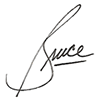Bonsai Bruce has exclusive permission to maintain a copy of the following article on this website thanks to the kindness and courtesy of Ashley Carrier of Bonsai Outlet. Please consider expressing your appreciation by purchasing your next bonsai tool or accessory from her!

Caring for Bonsai Tools
by Ashley Carrier, Bonsai Outlet
Copyright © 2005 - 2024
Clean bonsai tools last longer
Caring for bonsai tools is far easier than working with dull or rusted ones and cheaper than buying new ones every few years. You've made a significant investment purchasing bonsai tools for cultivating and training bonsai. If nothing else, your bonsai tools should be properly cleaned after each use.
Not only are properly maintained bonsai tools easier and safer to use for the gardener, but they are better for your plants. Cuts made with sharp clean tools will allow your bonsai to heal faster than cuts made with poorly maintained tools — makes sense, right? If you clean your bonsai tools after each use, they should never need major work.
How to care for your bonsai tools
Always inspect your bonsai tools after each use to be sure they are in good working order. For the most part, these are sharp instruments and deserve your respect.
With a little care, bonsai tools will keep their edges for many years without sharpening. Put the following maintenance measures to practice and you'll enjoy your bonsai tools for many years.
- Clean Bonsai Tool - Clean each bonsai tools of debris and dirt with a cloth. Be gentle. And be careful — the blades are very sharp.
- Remove Sap - If the blade on your bonsai shears has sap on it, use a little soapy water to remove it. Neglecting to remove the sap will likely cause your bonsai tools to rust.
- Remove Stains - Remove all difficult stains with a piece of bamboo or wooden spatula. Specially made cleaning oils such as Tri-Flow will also help loosen stains and add lubrication to help the blades resist rust between gardening jobs.
Note: Bonsai Outlet recommends using Tri-Flow as it does not attract dust like other lubricants, however, lubricants such as 3-in-1 oil or choji oil will work fine.
- Oil Bonsai Tools - Wipe your bonsai tools dry with clean rag, and then spray Tri-Flow on them to protect the metal from corrosion, especially if you store your bonsai tools in a damp garage or basement.
Ideally bonsai tools should be cleaned and oiled after each use. Also, keep in mind that tools stored and subjected to humidity fluctuations will also corrode at an accelerated rate due to moisture condensation. Keep these tools well oiled to protect them.
Treatment for rusted tools
Rust on your bonsai tools can be more than just frustrating; it can actually hurt the performance of the tool.
Rusty tools require special attention. Even after removing dirt and sap, bonsai tools are still susceptible to rust when exposed to oxygen. So, considering the high cost of quality bonsai tools, it makes sense to keep rusting to a minimum.
The appearance of a rusty tool can be improved with a product called SandFlex "Rust Eraser". When starting out with a pitch-encrusted or rusted blade the SandFlex eraser will scrub rust, corrosion or tarnish off any metal in a hurry and leaves a beautiful polish.
- Remove Rust - Use a rust eraser like SandFlex to remove light coatings of rust. Be sure any residue is carefully washed and rinsed away. SandFlex is the fastest, most cost-effective hand tool we know of for eliminating rust and stains on tools.
Note: SandFlex is a grit-embedded (tiny abrasive particles) scoring block and is great for removing sap and rust from any bonsai tool without damaging your tools cutting edge. SandFlex blocks will last for years of rust removal. Do not confuse these with the standard sanding blocks you can buy home improvement stores. These have abrasive material through the whole block. As the block wears, new abrasive material is uncovered.
- Apply Rust Prevention Oil - Once the rust is removed, apply a coat of Tri-Flow to the newly exposed steel to stop the oxidation process in its tracks.
Caring for bonsai tools is far easier than working with dull or rusted ones and cheaper than buying new ones every few years. Follow all the above steps and you'll enjoy your bonsai tools for years.
Associated topics
- While submerging your tree for a few minutes won't hurt it, it may wash soil, rocks, and fertilizer away. Make sure you keep plenty of extra supplies on hand.
- Humidity trays can help too. A soaked bonsai may need to drain for several minutes, so humidity trays can help trap the water.
- And if you're displaying your bonsai on fine furniture, you should consider a placing your tree on a well-matched bonsai stand. Why risk water damage or other unsightly water marks?
This entire article is copyright © 2005 - 2024, Bonsai Outlet. All rights reserved.